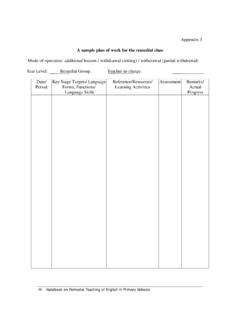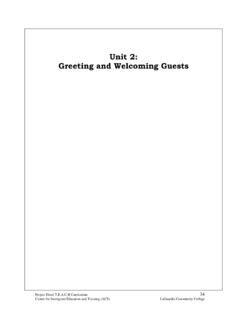Transcription of All-on-4® treatment concept Procedures manual
1 All-on-4 treatment conceptProcedures manualNote: In order to improve readability, Nobel Biocare does not use or in the running text. By doing so, however, Nobel Biocare does not waive any right to the trademark or registered mark and nothing herein shall be construed to the : Some products may not be regulatory cleared/released for sale in all markets. Please contact the local Nobel Biocare sales office for current product assortment and protocol for All-on-4 treatment conceptThe All-on-4 treatment concept is a rehabilitation concept that maximizes the use of available bone. The surgical and prosthetic Procedures follow a strict protocol including the products to be used. The success of the All-on-4 treatment concept is due to these specific protocols and products, namely NobelSpeedy implants, which have been used with 10 years of follow-up. For the long term follow-up studies supporting the result and the success rate of the All-on-4 treatment concept , please visit or ask your Nobel Biocare representative for All-on-4 and the All-on-4 with NobelGuide treatment concepts were developed together with Paulo Malo, DDS, PhD.
2 At MALO proven and successful concept 4 Conventional versus guided surgery 5 Conventional surgeryQuick guide 6 treatment planning 7 Clinical procedure for edentulous mandible 8 Clinical procedure for edentulous maxilla 11 Laboratory procedure 12 guided surgeryOptimized implant placement and prosthetic outcome with NobelGuide 13 Quick guide 14 treatment planning 15 Clinical procedure 18 Laboratory Procedures 22 Product informationFinal restorations 26 Multi- unit Abutments 27 Surgical components 31 Laboratory components 33 AppendicesClinical cases 35 Customer service worldwide 394 All-on-4 treatment concept manual // IntroductionA proven and successful conceptOnly four implants neededThe All-on-4 treatment concept , with its use of straight and angled Multi- unit Abutments, was developed to provide edentulous and soon-to-be edentulous patients with an immediately loaded full-arch restoration on only four implants two placed vertically in the anterior, two placed at an angle of up to 45 in the posterior tilting the two posterior implants, the bone-to-implant contact is enhanced, pro-viding optimized bone support even with minimum bone volume.
3 Additionally, tilting of implants in the maxilla allows for im-proved anchorage in better quality anterior bone and bicortical anchorage in the cortical bone of the sinus wall and the nasal of the posterior implants also helps avoid vital structures, such as the mandibu-lar nerve or the maxillary sinus, and results in a better distribution of implants along the alveolar crest, which optimizes load distribu-tion and allows for a final prosthesis with up to 12 AbutmentsNobel Biocare offers straight, as well as 17 and 30 angled Multi- unit Abutments for all Nobel Biocare implants and a selection of other major implant systems. The abutments are available with various collar heights to match the thickness of the soft temporary prosthetic solutionsWith the All-on-4 treatment concept , patients benefit from an immediate implant-supported all-acrylic restoration, as a provisional prosthesis is screwed onto the implants right after restorative solutionsFinal solutions include both fixed and fixed-removable prostheses: Fixed solutions include NobelProcera Implant Bridge with acrylic veneering, or individual NobelProcera crowns cemented to the bridge framework.
4 Fixed-removable solutions include acrylic prosthesis on a NobelProcera Implant Bar Overdenture, attached by means of a variety of attachment Implant Bridge and Implant Bar Overdenture are milled from a biocom-patible titanium monobloc using state-of-the-art CAD/CAM technology, resulting in consistent precision of fit, individualized design and optimized surgeryThe All-on-4 treatment concept can be planned and performed using NobelGuide, ensuring accurate diagnostics, planning and implant placement. Insertion of implantsSecuring of Multi- unit AbutmentsSecuring of provisional prosthesis with prosthetic screwsAll-on-4 treatment concept step by step5 All-on-4 treatment concept manual // IntroductionConventional versus guided surgeryConventional flap procedure with traditional planning and a standardized All-on-4 Guide for predictable and optimized positioning of the implant systems NobelSpeedy Groovy Br nemark System Mk III and Mk IV* NobelActive** NobelParallel Conical Connection** NobelReplace Conical Connection**, NobelReplace/Replace Select Tapered and NobelReplace Platform Shift NobelReplace/Replace Select Straight and NobelSpeedy Replace3D diagnostics and treatment planning and a custom- designed surgical template to correctly drill and position the All-on-4 treatment concept can be performed in two ways.
5 Conventional surgery raising a flapNobelGuide flap to flapless approach* guided surgery is only available for Br nemark System Mk III Groovy and Shorty and Br nemark System Mk III TiUnite RP.** Non-engaging 30 Multi- unit Abutments are not available for implants with internal conical treatment concept manual // Conventional surgeryQuick guide conventional surgeryMaxilla Mandible7 All-on-4 treatment concept manual // Conventional surgeryGeneral considerations Ability to achieve primary implant stability: - Implants should withstand a minimum tightening torque of 35 Ncm. - If this tightening torque is not achieved, a conventional healing phase is recommended prior to delivery of the provisional or final restoration. No severe parafunctions. Indicated for edentulous maxilla with a minimum bone width of 5 mm and a minimum bone height of 10 mm from canine to canine. Indicated for edentulous mandible with a minimum bone width of 5 mm and a minimum bone height of 8 mm inbetween the mental foramina.
6 To reduce the cantilevers, tilt the posterior implants to a maximum of 45 . If the angulation is 30 or more, it is necessary to splint the tilted implants. For tilted posterior implants, plan the distal screw access holes to be located at the occlusal plane of the first molar, second pre-molar, or first pre-molar. The All-on-4 treatment concept does not require a wider opening of the mouth than a treatment with straight im-plants due to the angulation of the posterior implants. If there are extraction sites, clean them thoroughly. It is advisable to place implants between extraction considerations prosthetics No extensions over one tooth on each side for an immediate all-acrylic bridge, which should have a maximum of 12 teeth. If the patient s removable prosthesis is in good condition, it may be used to fabricate the immediate all-acrylic bridge. For proper esthetics and function, the final bridge should have 12 teeth and a supporting metal considerations implants If possible, the posterior implants should be mm or mm.
7 When placing posterior implants with: - internal tri-channel connection: make sure that one of the tri-channel lobes is pointing distally or slightly buccally. - internal conical connection: make sure that one of the flat sides of the hexagon is parallel to the buccal : The implant drivers have markings to facilitate proper orientation of the : For internal tri-channel and external hex connection, the 30 Multi- unit Abutment is only available for RP implants. The 17 Multi- unit Abutment is available for NP and RP implants. For internal conical connection, the 17 Multi- unit Abutments are available for NP, RP and WP implants, and the 30 Multi- unit Abutments for NP and RP planningThe All-on-4 treatment concept was developed to maximize the use of available bone and to allow for Immediate Function. When planning a conventional treatment using a flap technique, consider the : For a full description of implant placement, prosthetic Procedures , and all instruments needed, please refer to the respective Procedures manuals (for the current version see ).
8 8 All-on-4 treatment concept manual // Conventional surgery2 Prepare posterior site Drill to appropriate depth using a 2 mm Twist Drill tilted to a maximum angle of 45 . Check for correct angulation with the All-on-4 Guide. Prepare the site according to the density of the bone. Insert the implant. For Immediate Function, the implants should withstand a final tightening torque between 35 and 45 Ncm. If indicated, use a Bone Mill together with a Bone Mill Guide to remove bone that could hinder correct seating of the abutment. Place a 30 Multi- unit Abutment. Tighten to 15 Ncm using Unigrip Screwdriver Machine and manual Torque Wrench Prosthetic. Perform the same procedure for the opposite posterior : It is important to identify the mental foramen and exiting inferior dental nerve. The final position of the implant should be in front of the foramen, avoiding the nerve Position All-on-4 Guide After making an incision for flap elevation, make an osteotomy of approximately 8 mm in the midline using a 2 mm Twist Drill.
9 Place the All-on-4 Guide in the procedure for edentulous mandibleThe images show Immediate Function with an all-acrylic bridge and NobelSpeedy Groovy RP treatment concept manual // Conventional surgery3 Prepare anterior site Prepare two anterior sites, as far apart from each other as possible, allowing for a safe distance from the apex of the posterior implants. If indicated use a Bone Mill together with a Bone Mill Guide to remove bone that could hinder correct seating of the abutment. Place straight or 17 Multi- unit Abutments and allow for proper emergence of the prosthetic screw. Tighten 17 Multi- unit Abutments to 15 Ncm using Unigrip Screwdriver Machine and manual Torque Wrench Prosthetic. Tighten straight Multi- unit Abutments to 35 Ncm using Screwdriver Machine Multi- unit and manual Torque Wrench : delayed loading If the required tightening torque for Immediate Function (minimum 35 Ncm) cannot be achieved or the treatment of choice is a delayed loading protocol, a conventional healing phase is recommended prior to delivery of a provisional or final restoration.
10 Place cover screws on all four implants and suture back the flap. Wait with further steps until osseointegration has taken treatment concept manual // Conventional surgery6 Connect provisional bridge Place the all-acrylic bridge on the abutments. Tighten the prosthetic screws to 15 Ncm using Unigrip Screwdriver Machine and manual Torque Wrench Prosthetic. Block out screw access and fill holes with suitable material. Check the Final restorationAfter a sufficient healing period, follow established prosthetic Procedures for the final restoration, preferably a NobelProcera Implant Laboratory procedure for provisional bridgeA model and a provisional restoration are made at the dental laboratory. For more information, see the step-by-step labo-ratory procedure on page Take an impression After suturing, connect the Multi- unit Impression Copings Open Tray to the Multi- unit Abutments. Take an impression using silicone soft putty material and a customized open : To avoid impression material entering into the tissue, always use a putty soft addition silicone.






